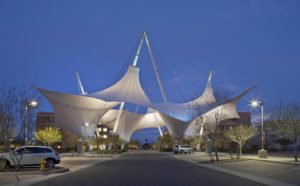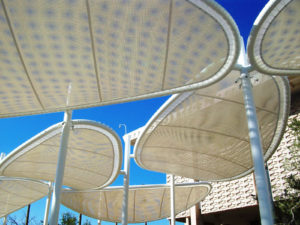
Industrial Fabrics Association International (IFAI) is celebrating the 30th anniversary of Fabric Architecture (FA) magazine. The inaugural issue editor, Gene Rebeck, touched on a number of topics that proved to be insightful, clairvoyant and representative of how FA (originally called Fabrics & Architecture or F&A) has been able to represent trends in thinking and practice from its onset. Under the heading “Concern for the environment,” Rebeck said: “F&A seeks to promote environmentalism in a broad sense—a creative interaction of humankind with its living space. F&A then, not only comes at the right time—it anticipates the future.”
This has proven to be prophetic, as architects and society today are revisiting the impact of buildings and construction on the environment, a movement that first began in the 1980s. Rebeck continues: “F&A anticipates the future, not only because signs show this interest will continue, but because they also suggest that fabrics of whatever size, whatever purpose, will play an increasingly important role in architecture and design.”
The first decade
A number of themes were repeated within Fabric Architecture’s issues of the first decade, including new materials and technical innovations; the importance of shading systems and fabric shade applications; form-making in tension structures; and the growth of bigger and better fabric structures throughout the world.
A landmark structure featured on the cover of the May/June 1992 issue was the Georgia Dome, the first major fabric-clad “tensegrity” dome sports facility that was designed by a consortium of architects led by Heery International, with a fabric roof designed by New York engineers Weidlinger Associates (now known as Thornton Tomasetti), led by master-of-the-membrane structural engineer Matthys Levy. Described as a “modern big top,” with allusion to circus tents, the Georgia Dome (now demolished) marked a number of fabric records: for size; for being more than a single purpose structure, because it was tied into a major new convention center, Georgia World Congress Center; and for having the world’s largest cable-supported roof, measuring 770 by 610 feet. Levy acknowledged the structurally unique concept came from engineering/architect guru R. Buckminster Fuller’s idea of a triangulated framing of membranes in which “islands of compression reside in a sea of tension.” It was a complex network of tension rings, suspended among cables and “flying masts,” all to prop up the roof. Fabric made it possible and affordable.
The July/August 1992 issue featured extensive coverage of “Expo 92” world’s fair in Seville, Spain, a marvelous showcase of appropriate use of fabric structures throughout the fairgrounds, another landmark in the history of tension structures.
The September/October 1999 issue was a newly redesigned magazine (with a new name, its current) that placed more emphasis on visual presentation of projects, more detail drawings and related technical data. The issue theme was about banner graphics, but the most unusual topic covered, in a structures column, was NASA’s research and design of inflatable fabric structures for use on the Moon and Mars. Written by NASA space architect Kriss Kennedy (yes, there are architects who design for space), the story showed numerous fabric structure options for deep space use, including the TransHab inflatable dwelling unit designed to attach to the International Space Station.
As the world turned toward the new millennium, Fabric Architecture saw at least two iconic structures revealed: The Millennium Dome, now called the O2 Dome, in 1999 in London, by Buro Happold, engineers with an international practice based in London; and the Japan Pavilion in 2000 at the Hannover World Expo, designed by Shigeru Ban with collaboration from Frei Otto, the grandfather-of-tensile-fabric-architecture.

Technical improvements
As Fabric Architecture evolved in its second era, new topics and emphases rose to the top, including: fabrication methods; technical improvements in membranes and textiles; fabric structures as a viable alternative to traditional architecture; the education of architects as its main audience; and discovering and reporting on new applications and building forms from around the world. These themes echoed the changing nature of IFAI itself as a more worldwide focus permeated the association as well as the magazine.
High points in this era included the introduction of education-based articles that linked with the American Institute of Architects’ (AIA) ongoing mandate of informed membership. Topics offered by the Continuing Education Learning Units (CEUs) covered many of the topics of a series of half-sized Sourcebooks that collated industry knowledge in a handy format, but awarded CEUs via an agreement with the AIA national record-keeping system. Another innovation, beginning around 2000, was the establishment of online visibility, acknowledging the digital trends of communication worldwide.
Special issue topics began to shape the editorial content, each issue gathering together feature stories on a single topic, with regular columns covering the industry basics like structures, shade, new products under the rubric “Fabric & fibers,” and reports from around the world of fabric architecture developments. Sustainable design became an every-issue topic. A case in point: the Jan/Feb 2004 issue focus, headlined “Global designs” with a revisit to Spain for its consistently innovative shading structures that seamlessly integrate into society. Several reports brought readers up to speed on international conferences, such as the Technical University of Berlin’s “Textile Roofs 2003” and IFAI’s “Fabric Structures 2003” held in Las Vegas with keynote speaker Dr. Kazuo Ishii, professor emeritus of Yokohama University, speaking on advances made in retractable roofs. Feature stories covered a sail-inspired shade structure in Malaysia, an office design in Oslo, Norway, a shopping, leisure and entertainment center in Madrid, Spain, and a tensile shaded resort in Colombia, South America.

Evolving times, new methods
By the start of FA’s third decade, the economy had gripped all aspects of the industry, the publication and the world financial scene. Innovation comes, necessarily, by responding to new ways of reaching architects. By this time, many print-based publications—newspapers as well as magazines—universally find that more content can be provided online at lower cost. FA responded by putting all CEU articles online, and began to schedule feature articles on related issues of concern to both designers and fabricators. The Jan/Feb 2010 issue cover topic was “Show me the money: How much does it cost to build fabric structures?” Emphasis was on underlining the message of fabric’s sustainable benefits; consequently, “Design for sustainability” became the tagline to the magazine’s cover logo. Shade became the energy lead-in for many of the stories of the regular issues, as well as the annual Resource Guides that showcased award-winning projects from IFAI’s international membership. The Jan/Feb 2010 issue also premiered a dynamic tensile shade structure called “Skysong,” designed by FTL Design Engineering Studio for the Arizona State University campus in Scottsdale, Ariz.
Several other key projects have been published in the last 10 years, such as a marvelous example of energy efficient interior shade for the Louis Vuitton Marina Bay Sands, Singapore, showroom by Moshe Safdie, with a shading system designed by FTL (Jan/Feb 2013); Zaha Hadid Architects’ Serpentine Sackler Gallery in London (April 2015); and more recently, a spectacular multi-colored ethylene tetrafluoroethylene (ETFE) train shed in Lodz, Poland, by Taiyo Europe GmbH and Buro Happold (2017 FA Resource Guide).
Today, Fabric Architecture reflects the culmination of some 30 years of in-depth reporting, technical information and shared resources from a knowledgeable industry of highly skilled manufacturers, fabricators and designers.
Bruce N. Wright, AIA, the former editor of Fabric Architecture, is a consultant to architects and designers, and frequent contributor to Fabric Architecture, Specialty Fabrics Review and Advanced Textiles Source.
 TEXTILES.ORG
TEXTILES.ORG


